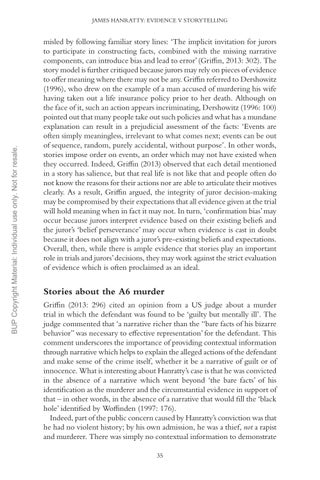BUP Copyright Material: Individual use only. Not for resale.
JAMES HANRATTY: EVIDENCE V STORYTELLING
misled by following familiar story lines: ‘The implicit invitation for jurors to participate in constructing facts, combined with the missing narrative components, can introduce bias and lead to error’ (Griffin, 2013: 302). The story model is further critiqued because jurors may rely on pieces of evidence to offer meaning where there may not be any. Griffin referred to Dershowitz (1996), who drew on the example of a man accused of murdering his wife having taken out a life insurance policy prior to her death. Although on the face of it, such an action appears incriminating, Dershowitz (1996: 100) pointed out that many people take out such policies and what has a mundane explanation can result in a prejudicial assessment of the facts: ‘Events are often simply meaningless, irrelevant to what comes next; events can be out of sequence, random, purely accidental, without purpose’. In other words, stories impose order on events, an order which may not have existed when they occurred. Indeed, Griffin (2013) observed that each detail mentioned in a story has salience, but that real life is not like that and people often do not know the reasons for their actions nor are able to articulate their motives clearly. As a result, Griffin argued, the integrity of juror decision-making may be compromised by their expectations that all evidence given at the trial will hold meaning when in fact it may not. In turn, ‘confirmation bias’ may occur because jurors interpret evidence based on their existing beliefs and the juror’s ‘belief perseverance’ may occur when evidence is cast in doubt because it does not align with a juror’s pre-existing beliefs and expectations. Overall, then, while there is ample evidence that stories play an important role in trials and jurors’ decisions, they may work against the strict evaluation of evidence which is often proclaimed as an ideal.
Stories about the A6 murder Griffin (2013: 296) cited an opinion from a US judge about a murder trial in which the defendant was found to be ‘guilty but mentally ill’. The judge commented that ‘a narrative richer than the “bare facts of his bizarre behavior” was necessary to effective representation’ for the defendant. This comment underscores the importance of providing contextual information through narrative which helps to explain the alleged actions of the defendant and make sense of the crime itself, whether it be a narrative of guilt or of innocence. What is interesting about Hanratty’s case is that he was convicted in the absence of a narrative which went beyond ‘the bare facts’ of his identification as the murderer and the circumstantial evidence in support of that – in other words, in the absence of a narrative that would fill the ‘black hole’ identified by Woffinden (1997: 176). Indeed, part of the public concern caused by Hanratty’s conviction was that he had no violent history; by his own admission, he was a thief, not a rapist and murderer. There was simply no contextual information to demonstrate 35

